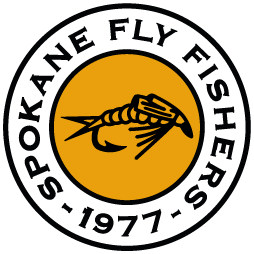By Ken Moore, Education Committee
Do trout have a favorite fly? I am often asked this question by beginning clients while guiding. Every guide is searching for that one unique fly that elicits a hook-up for their clients. On any given day, I cannot predict what a trout will choose to chow on. I do not think that any fly fisherman truly knows what the trout will eat from the parking lot. Over time we all develop confidence flies; those flies by size, shape, color and just the proper amount of wiggly parts give us as much confidence as a four-year-old in a Batman suit. This article examines how I choose my presentation flies when I am befuddled and cannot identify what the fish are eating.
How do you figure out what fly a fish will prefer? The most obvious way is to watch the trout. Determine what she takes or seine the water and see what available food sources the trout might select. With small flies or emergers, it is often challenging, if not impossible, to see what the fish are eating. Two items that I usually carry with me are a seining net that goes over my landing net and a small pair of binoculars to assist me in determining the type of fly (mayfly, caddis, or midge). Make no mistake, first; you need to figure out what the available food source is. If I cannot determine that- say, I left my seine in the truck. I use a hierarchy taught by Orvis’s Tom Rosenbauer to choose a fly. If I can capture the fly or pupae, then my confidence in my selection increases, but if not, then I defer to the groupings below. (We won’t discuss insects returning to the water, like mayfly spinners or spent caddis (let’s save that for another article).
Grouping 1. (most likely): Emerging mayflies and mayfly spinners
Grouping 2 (reasonably likely): Caddis pupae, midge pupae, mayfly duns, spent caddis
Grouping 3 (possibly): Caddis adults, terrestrials
Grouping 4 (unlikely but possible): Adult midge, stone-fly adults, crane flies
Of course, you would temper the above groupings with particular circumstances. If big adult Golden Stones or Salmon flies are skittering all over the water, you will focus on these flies if you observe the fish eating them. If I saw a few stoneflies and the trout were not paying a lot of attention, I would default to the group 1 or 2 flies.
There are two ways to use these listings: 1) I highly recommend the Pocket guide to Western Hatches by Dave Hughes. It is a small book that I carry in my truck. I like the book, especially for beginner and intermediate casters, because it shows a picture of the actual fly and how the imitation fly appears. Mostly this is one of the best reference guides on hatches in the west, and you won’t have to become an entomologist to understand the book. 2) If you ever find yourself standing in front of a bin of flies in a fly shop, concentrate your purchasing dollars on grouping 1 and 2.
One of the tricks to this sport is making it as simple as possible ask my wife how she selects flies. She will respond, “anything with pink in the makeup of the fly.” She catches fish, much to my professional dismay.
If you have questions, comments, or just want to talk fishing, my number is 509-953-8669. Be safe and make the first cast count- one cast.
Ken
